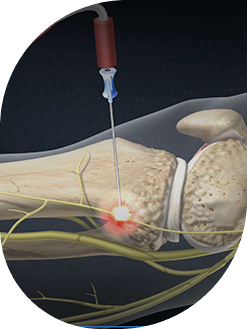Overview
During this outpatient procedure, the physician uses a radiofrequency device to heat up and disrupt the genicular nerves. These are the sensory nerves that transmit pain signals from the knee to the brain. Disrupting these pathways can provide long term relief from knee pain.
Is it right for me?
If you are experiencing severe knee pain that has not responded to other treatments, a genicular nerve ablation may be an option for you.
What is the procedure like?
In preparation for the procedure, the patient may be given an IV and a mild sedative to help relaxation. The skin of the knee is cleaned and sanitized. The physician numbs the skin with a local anesthetic. Using a fluoroscope (a type of x-ray device that shows video images from within the body), the physician carefully guides a needle through the skin and down to the target nerve. A thin electrode is passed through this needle. When the electrode is activated, it heats up the nerve. This heating process, called ablation, is not painful. It will eliminate the nerve's ability to transmit pain signals. The ablation process is repeated at two more locations to treat three of the genicular nerves.
What happens after the procedure?
When the procedure is complete, the knee is bandaged. The patient is monitored for a short time before being released. The leg may feel numb for a short time after the procedure until the anesthetic wears off. Pain relief should begin immediately, and may last for several months.


